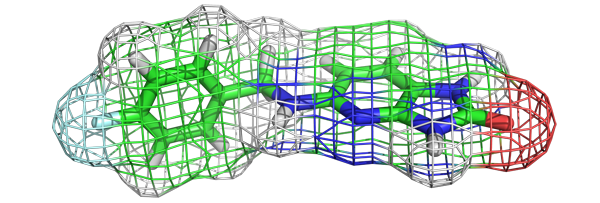Medicinal Chemistry and Pharmaceutical Analysis
Synthetic Medicinal Chemistry and Instrumental Pharmaceutical Analysis

Drug Design
Direction of Work
The working group Pharmaceutical/Medicinal Chemistry works on projects from the field of medicinal chemistry and pharmaceutical analysis. Our work in the field of medicinal chemistry currently concerns the modification to toxic drugs such as flupirtine and retigabine and the provision of "multipurpose screening compounds" as well as tailor-made modulators of enzymes of epigenetic gene regulation. In addition to organic synthesis of new molecules, structure determination, structural assurance and purity control of synthesis products are processed as a prerequisite for the provision of test substances for drug screening. In iterative cycles of testing and synthesis, structure-activity relationships and structure-toxicity relationships are derived to find substances with a favorable ratio of activity to toxicity. In detail, collections of sp3-rich test substances are synthesized, characterized and forwarded to cooperation partners for biological evaluation. Recently, we were able to publish a flupirtin analogue in which the therapeutic quotient could be increased from 81 to over 25,000 and at the same time the maximum potassium channel-opening effect on voltage-gated KV7.2/7.3 channels was increased to 130% of the comparison flupirtin. Due to the lack of crystal structure data from KV7.2/7.3 channels, a ligand-based approach had to be chosen. Crystal structures of our new lysindesmethylase inhibitors, on the other hand, have already been solved by Manfred Weiss' research group at Bessy in Berlin and deposited in the Protein Data Bank.
In addition to applications of NIR spectroscopy in research and teaching, analytical work in recent years has focused on the separation, identification and quantification of drug metabolites by means of fluid chromatography with liquid carbon dioxide (Supercritical fluid chromatography, SFC). By online coupling of solid phase extraction with supercritical CO2 (Supercritical fluid extraction, SFE), online SFE-SFC-MS methods could be developed that enable a particularly fast and environmentally friendly screening of ketamine metabolites from subject urine. While the anesthetic effect of ketamine is attributed to NMDA receptor blockade, which is 4 times more pronounced for the S-enatiomer than for R-ketamine, the basics of the antidepressant effect are still unclear. Our work should contribute to putting the use of the anesthetic ketamine for the treatment of severe depression on a rational basis. So far, it is unclear whether ketamine itself, if so which enantiomer, or its metabolites is responsible for the clinically usable antidepressant side effect of ketamine-containing drugs and why ketamine has good efficacy in only about half of the patients with this off-label use. An S-ketamine nasal spray developed for the indications of therapy-resistant depression and severe depression with an increased risk of suicide was only convincing to a limited extent in clinical studies. Presumably, a preparation with racemic ketamine would have been the better choice here. Since our methods simultaneously allow chiral separations of acidic and basic analytes in a chromatography run and even make processing by liquid-liquid extraction unnecessary, previously overlooked metabolizition patterns could thus be efficiently investigated as well as samples from larger patient populations. In this way, a connection between treatment failures and individual metabolism could be sought and patient stratification could be made possible.
